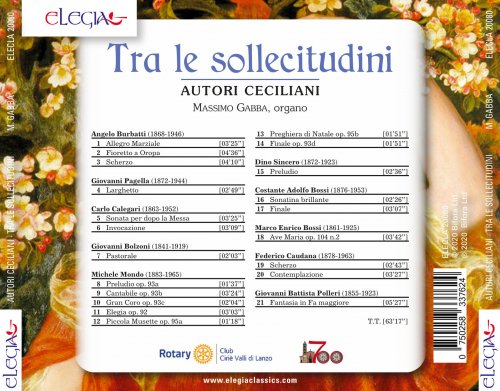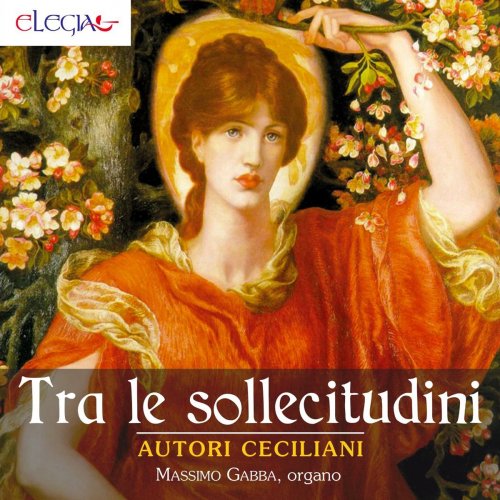
Massimo Gabba - Tra le sollecitudini (Autori ceciliani) (2020)
BAND/ARTIST: Massimo Gabba
- Title: Tra le sollecitudini (Autori ceciliani)
- Year Of Release: 2020
- Label: Elegia Classics
- Genre: Classical
- Quality: FLAC (tracks+booklet)
- Total Time: 63:07 min
- Total Size: 280 MB
- WebSite: Album Preview

Tracklist:
01. Allegro Marziale
02. Fioretto a Oropa
03. Scherzo
04. Larghetto
05. Sonata per dopo la Messa
06. Invocazione
07. Pastorale
08. Preludio, Op. 93a
09. Cantabile, Op. 93b
10. Gran Coro, Op. 93c
11. Elegia, Op. 92
12. Piccola Musette, Op. 95a
13. Preghiera di Natale, Op. 95b
14. Finale, Op. 95d
15. Preludio
16. Sonatina brillante
17. Finale
18. Ave Maria, Op. 104 No. 2
19. Scherzo
20. Contemplazione
21. Fantasia in F Major
In Italy towards the end of the nineteenth century the Cecilian Movement was formed, a title assumed by a musical movement that reformed sacred music within the Catholic Church. Named in honor of Santa Cecilia, patron saint of music, it was a response to the centennial and almost total absence of Gregorian chant and Renaissance polyphony from Catholic liturgical celebrations in favor of styles more similar to operatic music. The main criterion of the new compositions was to be greater sobriety and the search, through singing, for participation in the liturgy of the assembly of the faithful. In this period various Scholae Cantorum were born in almost all the parishes, choral groups dedicated to liturgical animation and the learning of musical art and the Diocesan Institutes of Sacred Music. Consequently, the art of organ building was also affected by the influence of this movement with the elimination of all those so-called concert registers, typical of the nineteenth-century Italian organ, in favor of less thunderous sounds. Therefore, reeds and mutations were replaced or canceled, with funds, mainly of 8 'and violating registers. In this period, in fact, the organ is renewed from a technical point of view: eliminated the octave scavezza (also called short octave or octave in the sixth) and the registers broken between bass and sopranos, a new transmission system was devised to replace the traditional mechanical one, pneumatic-tubular transmission. Among the musicians who gave life to the Cecilian Movement were Giovanni Tebaldini (Brescia, 7 September 1864 - San Benedetto del Tronto, 11 May 1952), predecessor of Lorenzo Perosi (Tortona, 21 December 1872 - Rome, 12 October 1956) in the position of Master of the Chapel in the Basilica of San Marco in Venice, even if all sources agree in identifying Perosi as the guide and the main exponent of the Cecilian Movement. Tebaldini himself admitted that what he had dreamed and hoped for had become reality thanks to the priest and composer from Tortona. The Cecilian Movement found its maximum support in the person of Pope Pius X (born Giuseppe Melchiorre Sarto. Riese, June 2, 1835 - Rome, August 20, 1914) who on November 22, 1903 (not surprisingly the day of Santa Cecilia), issued what it is considered the manifesto of the movement, that is the Motu Proprio Inter pastoralis officii sollicitudines, in which he reaffirmed all the concepts dear to the Cecilianists and exhorted the whole Catholic Church to conform to them. Edgardo Pocorobba.
Year 2020 | Classical | FLAC / APE
As a ISRA.CLOUD's PREMIUM member you will have the following benefits:
- Unlimited high speed downloads
- Download directly without waiting time
- Unlimited parallel downloads
- Support for download accelerators
- No advertising
- Resume broken downloads


